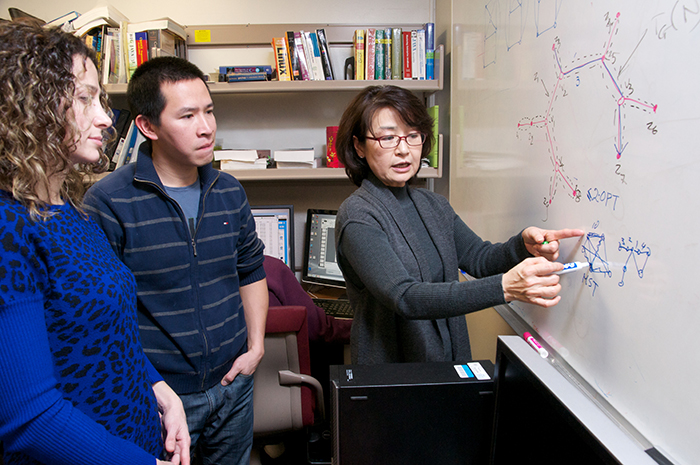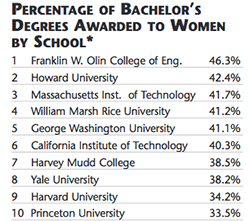As an undergraduate at the George Washington University, Katheryne Hernandez was not particularly phased by the fact that just one of her core engineering courses was taught by a female professor. In one class of 10 students, she was one of two women and the only Hispanic person.
It “felt natural” to be in the minority, she said—even as she struggled to participate in classes that were dominated by her often more assertive and vocal male classmates.
Now, in her final semester at GW, three of Ms. Hernandez’s four professors are women. And for the budding mechanical engineer, having female role models in her department is a welcomed change.
“The things that stood out to me were how impressive they were and how much confidence they had in their work,” said Ms. Hernandez, who is graduating from a five-year B.S./M.S. program in mechanical and aerospace engineering this month. “It really made me think, ‘I want to be like them.’ They helped me build my own confidence.”
Ms. Hernandez’s experience is reflective of a major shift happening within the School of Engineering and Applied Science (SEAS): It is becoming increasingly diverse.
It is no secret that women have been historically underrepresented in science, technology, engineering and mathematics (STEM) fields. Although women outnumber men among college graduates, men still earned the majority of bachelor’s degrees in engineering, computer science and physics in 2011, said a report from the National Science Foundation.
Women make up half of the U.S. workforce, but only one out of seven engineers is female, according to a 2011 U.S. Department of Commerce study. Though the numbers are on the rise, 22 percent of all engineering doctoral degrees were awarded to women in 2012, and only around 14 percent of all U.S. engineering faculty members were female during that year, according to the American Society for Engineering Education (ASEE).
Further, gender bias persists at American universities—a 2012 report by researchers at Yale University concluded that science professors widely regard female undergraduates as less competent than their male peers.
At GW, SEAS is making a strategic effort to reverse this trend, by recruiting and retaining highly qualified female students and faculty members, said Dean David Dolling. And the school is finding success.
In the past five years, SEAS has hired 41 new faculty members, making a concerted effort to recruit female faculty—including “BioWoman” Lijie “Grace” Zhang, star-gazer Zoe Szajnfarber and sea lion investigator Megan Leftwich. In 2013, half of all the school’s faculty hires were women.
“If women believe that engineering as a discipline is not open or welcoming to them, then we lose out on the talents and contributions they can bring to it.”
David Dolling, dean of the School of Engineering and Applied Science
As of spring 2014, 19 of the 86 tenure and tenure-track faculty members in SEAS—or 22 percent—are female. 37 percent the SEAS undergraduate population is female, slightly more than double the national average of 18 percent female enrollment in 2011.
|
| Data from "Engineering by the Numbers," a 2012 American Society for Engineering Education report |
GW has also put an increased focus on retaining those students. In 2011, 31 percent of all bachelor’s degrees in SEAS were awarded to women. By 2012, that number jumped to 41 percent, putting GW among the top five schools in the country for the percentage of bachelor’s degrees awarded to female students, according to an ASEE report.
In the Department of Mechanical and Aerospace Engineering alone, four female faculty members have been hired in the past four years—a shift that was noticeable to both Ms. Hernandez and Lorena Barba, an associate professor who was hired last summer.
“When I was looking at GW, a year before I negotiated my offer, there was only one female faculty member listed in the department,” Dr. Barba said. “By the next year, there were three, and now there are four. What an incredible improvement I’ve seen before my eyes.”
Department Chair Michael Plesniak said that hiring outstanding female faculty members has been one of his top priorities, with strong support from university administrators and Vice Provost for Diversity and Inclusion Terri Harris Reed.
“While these numbers are higher than the national averages, we are striving to further improve them,” said Dr. Plesniak. “Our increasingly diverse faculty serve as role models and mentors to all of our engineering students and bring to our department the innovation, breadth and perspective that comes with diversity.”
Dr. Dolling’s vision is to put SEAS “at the forefront” of engineering schools in recruiting and welcoming women as well as helping women to thrive.
“If women believe that engineering as a discipline is not open or welcoming to them, then we lose out on the talents and contributions they can bring to it,” he said.
Strengthening the Pipeline
When it comes to strengthening the pipeline of female engineering talent, experts agree: Early exposure to STEM is critical.
The daughter of a Chilean Navy officer, Dr. Barba received pilot training from her father in Chile at a young age, logging her first solo flight when she was only 17.
She said it was her pilot training and many hours spent with the maintenance staff at the flying club that led her to a career in mechanical engineering. Dr. Barba is still investigating flight in her current research.
“I think that if you’re a teenage girl and it hasn’t been around you, if it hasn’t been shown that it’s something you can do, then it’s hard to have that inspiration on your own—because the cultural expectation is that you would not do something technical,” she said. “Those expectations are very pervasive, and they’re hard to run away from.”
A 2013 study published in the American Educational Journal showed that exposure to math and science has a bigger impact on students’ intent to major in a STEM field than does math achievement.
The same study also showed that male high school students reported more belief in their own math skills than female students with comparable achievements.
A 2010 study released by the American Association of University Women found that factors like beliefs about intelligence, stereotypes, self-assessment and spatial skills, depressed the number of girls who enter the STEM fields. The report also said that the “climate” of a department makes a “big difference about who’s attracted to the major” and the “the active recruitment of students is absolutely necessary.”
GW has had a long history of recruiting and retaining young women into engineering.
After graduating with a B.S. in chemistry in the 1960s, Rachelle Heller moved to Washington, D.C. She began pursuing jobs and set up a meeting with an FBI employee.
“At the end he asked if anything looked interesting, and I said the forensics lab looked good. And he said, ‘Well, we don’t hire women as chemists. We hire them as secretaries.’ So I went home and cried,” said Dr. Heller, a professor in the Department of Computer Science and associate provost for academic affairs at the Mount Vernon Campus.
But she persevered. Dr. Heller found a job at Planning Research Corporation, moved on to IBM, obtained a Ph.D. at the University of Maryland and joined the engineering faculty at GW in 1985.
From 1989 through 1993, Dr. Heller and Vice Provost for Faculty Affairs Dianne Martin (who was a computer science professor at the time) began a program, funded by the National Science Foundation, intended to motivate minority high school girls to continue studies in STEM.
During each year of the four-year program, 24 minority female students in grades nine or 10 were selected from the greater Washington, D.C. area to participate in a 10-month program to learn computer skills as a vehicle to interest them in STEM careers.
The objectives of the project were to allow young minority women to interact with female scientists as role models for potential future careers in engineering, and to help the students develop a peer network who had similar interests in STEM.
The program was fairly revolutionary at the time, said Dr. Heller, but even in 2014—as the climate for young women in STEM is slowly becoming more welcoming—GW still recognizes the importance of motivating girls to study science at an early age.
Last week, Dr. Dolling announced a collaboration between SEAS, the Columbian College of Arts and Sciences (CCAS) and the Holton-Arms School—an all-girls school located in Bethesda, Md.—that will aim to do just that.
The Holton-Arms Center for the Advancement of STEM is an integrated, grade 3-12 curriculum that educates girls “to be fluent, not just literate” in the STEM fields. The GW/Holton-Arms collaboration will provide research internships for Holton STEM scholars at SEAS and CCAS, provide SEAS and CCAS faculty as guest lecturers on STEM topics at Holton-Arms and facilitate collaboration between GW faculty and Holton-Arms students.
The new collaboration is intended to strengthen the pipeline for girls in engineering from high school to college.
At GW, there have also been recent efforts to overcome unconscious hiring biases that may work against diversity in hiring, said Dr. Martin.
Associate Provost for Faculty Recruiting and Personnel Relations Annie Wooldridge meets with department search committees to discuss unconscious bias, using materials from a University of Washington program called “Interrupting Bias in Faculty Searches.” Additionally, the university holds a session each summer to train new department chairs and associate deans during academic leadership sessions.
“Increased diversity in the faculty means that exciting new research areas are brought into SEAS, especially in interdisciplinary research that cuts across departments and schools,” Dr. Martin said.
Greater Diversity, Greater Discoveries
It may be one of the most compelling arguments for the need for more female and minority professors in STEM: Simply, it can lead to better scientific outcomes.
“This is not about affirmative action,” said Dr. Barba. “This is about improving the quality of our knowledge-making environment. If you have more diverse people in a team, you will get more creative solutions to any problem.”
The Anita Borg Institute for Women and Technology recently backed up this claim in a new paper, “The Case for Investing in Women.”
Further, Dr. Heller points out, women have tremendous purchasing power in America, and it’s growing. The bottom line is that more women in leadership roles improves a company’s bottom line.
“If your service or product has been developed with input from women, you’re advantaging yourself,” Dr. Heller said. “If a woman designed a car, when I opened the door, there would be a convenient place for my purse.”
Faculty diversity also leads to diverse teaching methods, said Ms. Hernandez. She was blown away when Assistant Professor Saniya LeBlanc gave her class an oral exam, something Ms. Hernandez had never experienced in an engineering course before.
As SEAS works to bridge the gap between men and women in STEM, Dr. Barba notes that society has a long way to go before men and women are truly equal in the field. But simply by measuring and prioritizing women, the school will become a more inviting place for the historically underrepresented group.
“Female professors are going to start introducing some of the change,” Dr. Barba said. “The whole process of governance at the university will be infused with these different points of view.”



